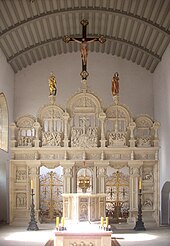Hildesheim Domlettner
The Hildesheim Domlettner is an image and ornament rich Renaissance - Lettner in Hildesheim . From 1960 to 2010 he stood in the St. Antonius Church near the cloister of Hildesheim Cathedral . It has been in the new building of the Hildesheim Cathedral Museum since 2015 . Until the war evacuation, it had its place in the cathedral itself as a liturgical barrier between the nave of the people and the high choir of the cathedral chapter .
The rood screen made of Baumberger sandstone is the work of Johann Brabender and was completed in 1546. Donor was the Canon Arnold Freitag.
The Hildesheim Domlettner shows the elevation of a representative Renaissance facade . It consists of a door and a lower gable storey and is divided vertically by pillars and columns into five zones, each crowned by a round arch. The middle, highest arch bears the triumphal cross , the slightly lower ones to the right and left of it are full sculptures of Mary and John under the cross. The ground floor has two wrought-iron , gilded doors, with a narrower passage between them that leads to the pulpit .
The arches and ribbons of the architectural structure are richly decorated with ornaments and paired putti and fantasy figures facing and facing away from each other, as well as with expressive, portrait-like faces.
There are five relief images in the gable area and two in the outer zones of the door storey , both on the former west (nave) side and on the east (choir) side facing away from today's visitor. These are representations of Old and New Testament scenes that are typologically assigned to one another . The selection of images may already go back to the previous lettner; the iconography , however, is modern and is demonstrably based on contemporary paintings and engravings .
The overall theme of the pictorial program is the vicarious sacrifice of Christ, which becomes a Eucharistic presence in front of the rood screen on the altar . The cross is therefore the summit and end point of all images. The erection of the copper snake is assigned to this in the image field below , flanked by the carrying of the cross and the burial of Jesus. On the far left is the sacrifice of Isaac , for which a ram stands; far right Jonah , who is thrown from the ship into the sea to rescue the passengers. These scenes appear on both the folk and the choir side.
In contrast, the four pictures next to the doors are different. The people's page continues the theme of the Mass offering with the Last Supper and the Melchizedek offering of bread and wine to Abraham (left) as well as Christ's victory over the realm of the dead and David's victory over Goliath (right). The choir side, on the other hand, shows the scenes of the Queen of Sheba before Solomon , the Adoration of the Magi , Queen Esther before Ahasver and the Coronation of Mary to the co-execution of the sacrifice of Christ by Mary and all believers.
The pulpit shows the risen Christ (center) as well as Mary and St. Bernward as cathedral patron and the four evangelists.
literature
- Karin Heise: The rood screen of the Hildesheim Cathedral , 2 volumes, Hildesheim 1998, ISBN 3-487-10553-5 .
- Victor H. Elbern : Dom and Domschatz in Hildesheim , Königstein 1979, ISBN 3-7845-4670-6 , pp. 17-18 and 55.
Individual evidence
- ↑ Authorship and year of installation are not proven beyond doubt. The inhibiting influence of the Hildesheim Reformation turmoil on the history of its origins is also unclear.

